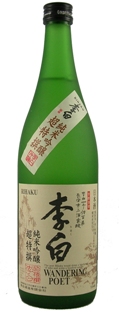 As noted, the top sommeliers in Texas converged in Dallas at the Four Seasons a few weeks ago. The best sommelier in Texas was tested and selected, and public and trade seminars were held for over 200 attendees.
As noted, the top sommeliers in Texas converged in Dallas at the Four Seasons a few weeks ago. The best sommelier in Texas was tested and selected, and public and trade seminars were held for over 200 attendees.
One session in particular opened my eyes to flavors that I was familiar with, but hadn’t ever really taken the time to get to know. Master Sommelier Keith Goldston led a Sunday morning session explaining the origin, nuances and uniqueness of sake, with its Korean roots, and unchanging Japanese production, and almost ceremonial enjoyment.
Sake, known as Nihonshu in Japan, is as important to the Japanese culture as Bordeaux and Burgundy are to the French.
Some of the basics that surprised me were that there are over 200 varieties of rice that the Japanese use in their culture, but only 28 are used in sake. Each of these 28 offer different flavor profiles, some with floral notes, some with mineral flavors, some with earthy richness. All in all, much like wine grapes…just with rice.
There are over 1300 Kura (sake breweries) in Japan making sake that ranges from15%-22% alcohol levels. Most breweries are located near water. The water can add as much to a sake’s flavor profile as the rice. Water is a key element especially when diluting the sake. Most sake’s are produced with upwards of 18%+ alcohol; water is used to lower the alcohol levels prior to bottling.
Most sake is consumed within 6 months of bottling. If you find older sake enjoy it, because it is rare…and expensive…. Sake is an appealing option for those of us who love wine, but sometime can’t drink it due to high acid levels. Sake is known for its low acid, zero sulfide pureness…and it tastes so good.
We tasted a variety of sake, looking at several different kinds from the same breweries and production: Hot vs. Cold; Filtered vs. Unfiltered; Pasteurized vs. Unpasteurized.
Here are some to try:
Rihaku “Wondering Poet” Junmai Ginjo vs. Rihaku “Wondering Poet” Junmai Ginjo (Nama) – Pasteurized vs. Non-Pasteurized. I was a fan of the non-pasteurized with a round, complex flavor. The pasteurized had a cleaner flavor, but a bit more pungent. The non-pasteurized requires refrigerated storage, unlike the pasteurized, and has a shorter shelf life.
Mantensei “Star Filled Sky” Junmai Ginjo – Warm vs. Chilled. I like warm sake, it has comforting qualities to me, and is very easy to drink. The chilled version really shows off the beauty of the sake though. Chilling the sake allows the elegant floral and defined mineral characteristics to shine.
Mukune “Root of Innocence” Junmai Ginjo vs. Mukune “Shadows of Katano” Junmai Ginjo – Filtered vs. Unfiltered. Loved the unfiltered (I love unfiltered wine as well like Newton’s Claret….leaving the wine unfiltered maintains depth of the wine with intense aromas and flavors.) The Unfiltered had smooth, clean, and approachable richness that was easily consumed at this mid-morning tasting.






